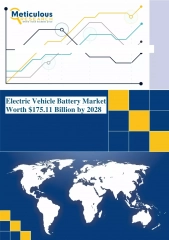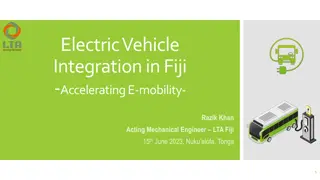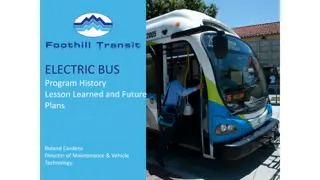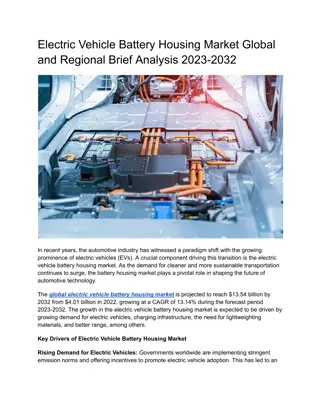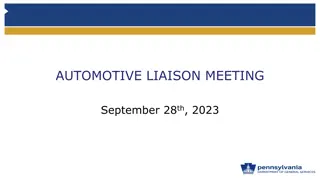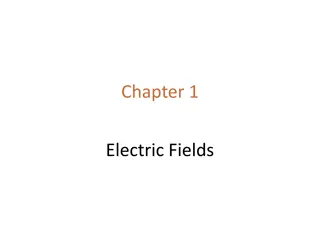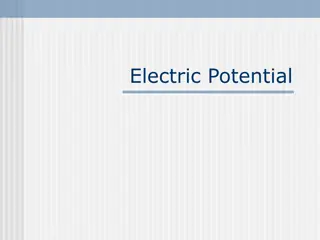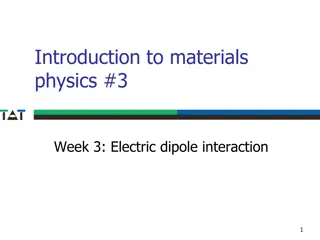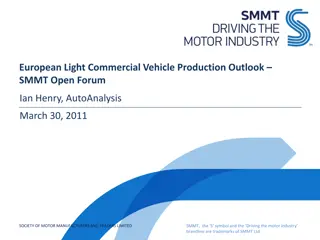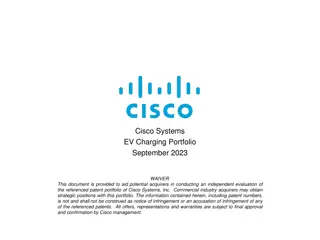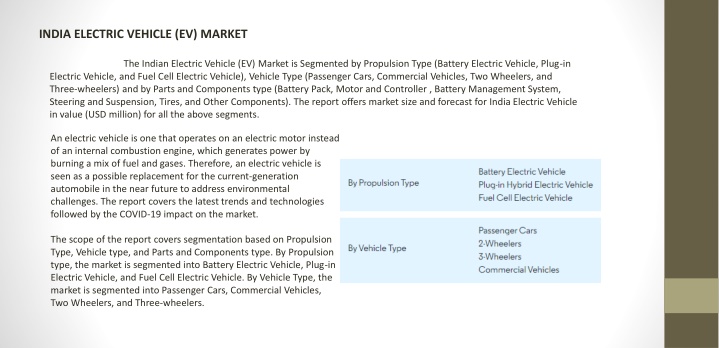
Overview of India's Electric Vehicle Market Trends
The Indian Electric Vehicle Market is evolving with a focus on promoting electric buses and vehicles through government initiatives and policies. The market segments by propulsion type, vehicle type, and parts/components type, indicating a shift towards eco-friendly transportation solutions amidst environmental challenges and global emissions targets.
Download Presentation

Please find below an Image/Link to download the presentation.
The content on the website is provided AS IS for your information and personal use only. It may not be sold, licensed, or shared on other websites without obtaining consent from the author. If you encounter any issues during the download, it is possible that the publisher has removed the file from their server.
You are allowed to download the files provided on this website for personal or commercial use, subject to the condition that they are used lawfully. All files are the property of their respective owners.
The content on the website is provided AS IS for your information and personal use only. It may not be sold, licensed, or shared on other websites without obtaining consent from the author.
E N D
Presentation Transcript
INDIA ELECTRIC VEHICLE (EV) MARKET The Indian Electric Vehicle (EV) Market is Segmented by Propulsion Type (Battery Electric Vehicle, Plug-in Electric Vehicle, and Fuel Cell Electric Vehicle), Vehicle Type (Passenger Cars, Commercial Vehicles, Two Wheelers, and Three-wheelers) and by Parts and Components type (Battery Pack, Motor and Controller , Battery Management System, Steering and Suspension, Tires, and Other Components). The report offers market size and forecast for India Electric Vehicle in value (USD million) for all the above segments. An electric vehicle is one that operates on an electric motor instead of an internal combustion engine, which generates power by burning a mix of fuel and gases. Therefore, an electric vehicle is seen as a possible replacement for the current-generation automobile in the near future to address environmental challenges. The report covers the latest trends and technologies followed by the COVID-19 impact on the market. The scope of the report covers segmentation based on Propulsion Type, Vehicle type, and Parts and Components type. By Propulsion type, the market is segmented into Battery Electric Vehicle, Plug-in Electric Vehicle, and Fuel Cell Electric Vehicle. By Vehicle Type, the market is segmented into Passenger Cars, Commercial Vehicles, Two Wheelers, and Three-wheelers.
Key Market Trends : Growing Adoption of Electric Buses The government of India has undertaken multiple initiatives to promote the manufacturing and adoption of electric vehicles in India, to reduce emissions pertaining to international conventions and to develop e-mobility in the wake of rapid urbanization. The National Electric Mobility Mission Plan (NEMMP) and Faster Adoption and Manufacturing of Hybrid & Electric Vehicles in India (FAME I and II) helped create the initial interest and exposure for electric mobility. For instance, in phase two of FAME, the government announced an outlay of USD 1.4 billion through 2022. This phase focuses on electrification of public and shared transportation through subsidizing, 7090 e-buses, 500,000 electric three wheelers, 550,000 electric passenger vehicles, and 1,000,000 electric two-wheelers. To promote the domestic electric vehicle industry, the Indian government has provided tax exemptions and subsidies to the EV manufacturers and consumers. As per the phased manufacturing proposal, the government has imposed 15% customs duty on parts that are used to manufacture electric vehicles and 10% on imported lithium-ion cells. The revised duty under PMP has been proposed from April 2021. States have also launched policies that support powertrain electrification by stimulating the demand, local manufacturing, research and development (R&D), and infrastructure development. Several states, like Delhi, Kerala, Karnataka, Telangana, and Andhra Pradesh, have formulated their own electric vehicle policies, while others are in the process of doing so. For instance, According to the Delhi Electric Vehicle Policy 2020, the government plans to have at least 50% e-buses for all new stage carriage buses and aims for 25% of the new vehicles to be electric by 2024.In March 2021, Delhi government announced its plans to introduce an interest subvention of up to 5% for electric vehicle (EV) purchases in the state. This initiative has been taken to promote the Delhi government s EV policy offering financial incentives on all categories of e-vehicles, i.e., two-wheelers, three- wheelers, four-wheelers, goods carriers, and electric rickshaws.
Key Market Trends : Growing Adoption of Electric Buses In February 2021, Delhi government announced a subsidy of Rs.30,000 for promoting e-rickshaws as last mile connectivity in Delhi. This, in turn, has led to the proliferation in their demand in the city, further benefitting the market. In wake of above-mentioned instances and developments, rising government initiatives expected to enhance demand in the market over the forecasted period.
Electric Two-wheeler Vehicles Likely to have Optimistic Growth Though COVID-19 pandemic resulted in lockdowns and supply chain disruptions increasing petrol and diesel prices, government incentives and increase in spending for setting up charging infrastructure in the country likely to drive demand in the country. For instance, In FY 2020, around 152,000 units of electric two wheelers were sold in the country as compared to 126,000 units sold in FY 2019. In the electric two-wheeler segment, electric motorcycles and scooters are popular modes, as like conventional two- wheelers, they are easier to navigate through congested roads, as is often the case in India. From a speed point of view, low speed (up to 25 km/hr.) and medium speed electric two wheelers (up to 40 kmph) with conventional lead-acid batteries projected to dominate the market over forecast period. This is mainly because in terms of upfront cost, they are already on par with ICE vehicles. However, with more companies becoming eligible for FAME-II incentives several new models expected to be operated in the market in coming years. Some of the key two-wheeler rental companies already started investing heavily in expanding their fleet of vehicles to cater the rising demand in the country. For instance, In February 2021, Bounce, bike rental start-up in the country made an announcement that they are planning to launch their own electric scooter in the country, however, the expected launch date is not declared. Price is expected to be around INR 55,000 and an additional INR 1450 per month for maintenance which includes battery maintenance. Several local major players in the country are investing heavily to enhance their production capacity of electric two-wheelers in the country with an aim to cater the enhancing the demand in the country. For instance,
Electric Two-wheeler Vehicles Likely to have Optimistic Growth In February 2021, Ampere electric made an announcement that they will be investing INR 700 crore in setting up new electric two-wheeler plant in Tamil Nadu. It will have the potential to start manufacturing 100,000 units in its first year of operation. Thus, with such growing advancements and developments passenger cars segment likely to witness steady and consistent growth during the forecast period.
Competitive Landscape The Indian EV market is moderately consolidated with the presence of major players in the market, owing to cheap and readily available manpower. The start-ups are also expanding their presence by raising funds from investors and tapping into new and unexplored cities. Companies are investing a tremendous amount in R&D and launching new models to mark their presence in the market. However, established players in the market are introducing new models to gain a competitive edge over other players. For instance, In August 2021, Tata Motors launched the new Tigor EV which gets Tata s advanced Ziptron high-voltage architecture that uses a permanent magnet synchronous electric motor producing 75hp and 170Nm. These output figures allow for a 0 to 60kph time of 5.7 seconds. In July 2021, Audi launched 2 EVs with e-tron SUV and e-tron Sportback . The e-tron SUV is available in e-tron 50 variant that a 71 kWh battery and two electric motors. This configuration puts out 308 bhp with 540 Nm and claims a driving range between 264 km and 379 km (WLTP) on a single charge. In February 2021, Ampere Electric, the wholly-owned electric mobility subsidiary of Greaves Cotton Ltd, announced phased investment potential of INR 700 crore over 10 years to set up a world-class e-mobility manufacturing plant in Ranipet, Tamil Nadu. A Memorandum of Understanding (MoU) to this effect was signed by the Company, with the Government of Tamil Nadu.


